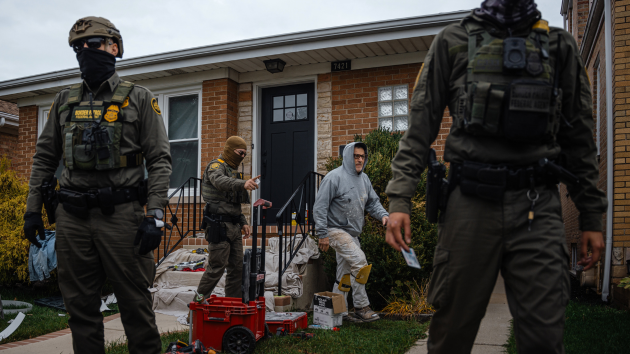Discrepancy between police accounts, evidence in Tyre Nichols case revealed
Written by ABC Audio ALL RIGHTS RESERVED on February 2, 2023

(MEMPHIS, Tenn.) — The police traffic stop that led to Tyre Nichols’ death was detailed in an incident report obtained by ABC News, as well as a Memphis Police statement, but the written statements provide a different account from what the body camera footage of the disturbing encounter has revealed.
Nichols, a 19-year-old Black man, died after a confrontation with police in which he was beaten following a traffic stop.
The footage shows officers beating Nichols and targeting him with pepper spray as he begins yelling for his mother, who lived near the site of the encounter.
In body camera footage, officers can be seen standing over Nichols while he’s on the ground. As two officers hold him down, a third kicks him. A fourth officer comes over with a baton and the officers pick up Nichols from the ground and hold him up while officers appear to strike him in the face and torso.
The officers yell multiple times at Nichols to “give me your hands.” The officer with the baton can be heard saying, “I’ma baton the f— out of you” – then appears to strike him on the upper body three times. Officers pull Nichols to a stand, then appear to punch and slap him.
The official incident report does not mention that Nichols was kicked and punched by the officers. It also claims that Nichols started to fight with officers, reached for their guns, pulled on their duty belts and grabbed at least one officer by his vest. This cannot be seen in body camera footage.
Officers can be heard in the aftermath claiming that Nichols reached for their guns.
“Suspect Tyre Nichols was refusing a lawful detention by law enforcement officers and he started to fight with detectives,” the report reads.
It says Nichols was “sweating profusely” and “irate” when he exited the vehicle.
The report also claims Nichols “began actively resisting by pulling duty belts and grabbing Officer Smith by the vest.”
It describes the use of chemical agents and the use of the baton to strike Nichols.
The report says the Memphis Police Department officer responded to an “aggravated assault” and that former MPD Officer Martin had observed Nichols’ vehicle “driving recklessly at a high rate of speed” and “into oncoming traffic.”
The initial statement from the Memphis Police Department failed to mention the details of the physical altercations.
It’s not the only example in recent years of police reports or statements not aligning with details seen in body camera footage or other evidence.
Some law enforcement experts and lawyers argue that when people are in fast-paced, high-intensity situations, they may not be equipped to “record” key details the way a body camera can.
“There’s no training that any human being can go through that is going to teach them how to record an event like a machine,” said Michael Rains, a California attorney who has represented law enforcement in civil and criminal litigation.
Two former law enforcement officers told ABC News that every person’s recollection of an event can differ.
“We learned to not say that eyewitness testimony is the only thing,” TJ Kennedy, a public safety and de-escalation expert, told ABC News. “You have to put it all together.”
However, “It’s not to say that an officer wouldn’t lie or try to lie because we all know that that can happen,” Rains adds.
Some officers get a chance to look at body camera footage before submitting their report, while others may not be allowed to because of local legal restrictions, according to ABC News contributor and former San Bernardino Police Chief Jarrod Burguan.
It’s an ongoing debate in the industry, he said. Does it help officers recollect the events? Or does it cause officers to change their narrative based on what they saw in the footage?
“Now we have that conflict between what is the officer perceiving versus what the actual camera is showing,” said Burguan in an interview with ABC News.
Discrepancies in police reports, official statements and official documents have been seen in several recent police brutality cases.
George Floyd incident
The Minneapolis Police Department also has been criticized over its initial statement detailing the murder of George Floyd by then-MPD Police Officer Derek Chauvin.
“After he got out, he physically resisted officers. Officers were able to get the suspect into handcuffs and noted he appeared to be suffering medical distress. Officers called for an ambulance,” read the May 26, 2020, statement.
The report fails to mention that Chauvin held his knee on the back of Floyd’s neck for more than 9 minutes, a moment captured on cellphone video by bystanders. The video prompted protests worldwide against police brutality.
Floyd, who was handcuffed and in a prone position on the pavement, repeatedly said he couldn’t breathe before falling unconscious and losing a pulse, according to evidence presented at Chauvin’s state trial.
Floyd was later pronounced dead at a hospital. Chauvin was convicted of second-degree unintentional murder, third-degree murder and second-degree manslaughter. He pleaded guilty to violating Floyd’s civil rights.
Breonna Taylor
Breonna Taylor was shot and killed in March 2020 by Louisville, Kentucky, police officers executing a no-knock search warrant on her home.
Her death became one of several that year that prompted global protests.
Details concerning the legitimacy of the search warrant unveiled by the Department of Justice in August 2022 prompted more ire.
The DOJ charged Detective Joshua Jaynes, former Louisville Detective Kelly Goodlett and Sgt. Kyle Meany for allegedly violating Taylor’s Fourth Amendment rights when they sought a warrant to search Taylor’s home while knowing they lacked “probable cause.”
The DOJ alleged that the officers knew their affidavit supporting the warrant contained false and misleading information and it omitted other material information, resulting in her death.
“Among other things, the affidavit falsely claimed that officers had verified that the target of the alleged drug trafficking operation had received packages at Ms. Taylor’s address. In fact, defendants Jaynes and Goodlett knew that was not true,” Attorney General Merrick Garland said during a press conference on the charges.
Garland also alleged that Jaynes and Goodlett knew armed officers would be carrying out the raid at Taylor’s home, and that conducting the search could create “a dangerous situation for anyone who happened to be in Ms. Taylor’s home.”
Goodlett pleaded guilty to one count of conspiring to violate the civil rights of Taylor. Jaynes and Meany have both pleaded not guilty. The next status hearing for the trial is scheduled for Feb. 21.
Casey Goodson
Casey Goodson, 23, was shot and killed by Franklin County Sheriff’s Office Deputy Jason Meade while Goodson entered his home on Dec. 4, 2020, in Columbus, Ohio.
However, the details of the fatal incident from authorities and Goodson’s family don’t match up.
Goodson’s family said he was returning from a dentist appointment and had a Subway sandwich in his hand, according to family co-counsel Sean L. Walton.
“Casey had the screen door open and his keys in the door, and Deputy Jason Meade fired shots at Casey,” Walton told ABC News. “He fell into the house, where he lay in his kitchen.”
Meade, who had been taking part in an unsuccessful search for a fugitive along with the U.S. Marshals Service, said Goodson — who was not the target of the search — waved a gun at him when he drove by in his police car.
Meade confronted Goodson outside his home, and Goodson allegedly refused to drop his gun, U.S. Marshal Peter Tobin said at a press conference. Tobin later withdrew those remarks about Goodson waving a gun.
Meade is charged with murder and pleaded not guilty.
Meade’s attorney, Mark C. Collins, has said in a December 2021 statement that his client “acted within his lawful duties as an officer of the law when he pursued Mr. Goodson,” and said Meade fired his weapon at Goodson in “fear for his life as well as those inside the house.”
Copyright © 2023, ABC Audio. All rights reserved.
 KVSP
KVSP 




